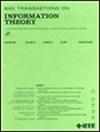Bh集和Costas立方
IF 2.9
3区 计算机科学
Q3 COMPUTER SCIENCE, INFORMATION SYSTEMS
引用次数: 0
摘要
Costas数组是一个排列数组,其中连接1对的向量都是不同的。Jedwab和Yen引入了科斯塔斯立方体,这是一种三维阵列,满足其三个二维投影为科斯塔斯阵列的条件。另一方面,如果所有形式为$a_{1} + a_{2} \cdots + a_{h}$的和(其中$a_{1}, a_{2} \cdots, a_{h} \in A$不同),则加性群G中的子集a是$B_{h}$集合。本文给出了所有$h\geq 3$的$B_{h}$集的三种新构造。此外,在$h=3$情况下,我们分析了这些集与Jedwab和Yen构造的Costas立方体的关系,并确定了这些立方体中哪些是$B_{3}$集。本文章由计算机程序翻译,如有差异,请以英文原文为准。
Bh Sets and Costas Cubes
A Costas array is a permutation array in which the vectors joining pairs of 1’s are all distinct. Jedwab and Yen introduced Costas cubes, which are three-dimensional arrays that satisfy the condition that their three two-dimensional projections are Costas arrays. On the other hand, a subset A in an additive group G is a $B_{h}$ set if all sums of the form $a_{1} + a_{2} \cdots + a_{h}$ , where $a_{1}, a_{2} \cdots, a_{h} \in A$ , are different. In this paper, we present three new constructions of $B_{h}$ sets for all $h\geq 3$ . Moreover, in the case $h=3$ , we analyze the relationship of these sets with Costas cubes constructed by Jedwab and Yen, and determine which of these cubes are $B_{3}$ sets.
求助全文
通过发布文献求助,成功后即可免费获取论文全文。
去求助
来源期刊

IEEE Transactions on Information Theory
工程技术-工程:电子与电气
CiteScore
5.70
自引率
20.00%
发文量
514
审稿时长
12 months
期刊介绍:
The IEEE Transactions on Information Theory is a journal that publishes theoretical and experimental papers concerned with the transmission, processing, and utilization of information. The boundaries of acceptable subject matter are intentionally not sharply delimited. Rather, it is hoped that as the focus of research activity changes, a flexible policy will permit this Transactions to follow suit. Current appropriate topics are best reflected by recent Tables of Contents; they are summarized in the titles of editorial areas that appear on the inside front cover.
 求助内容:
求助内容: 应助结果提醒方式:
应助结果提醒方式:


